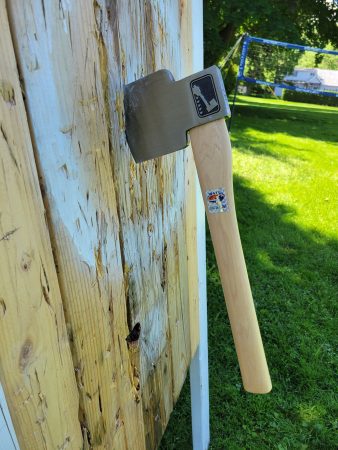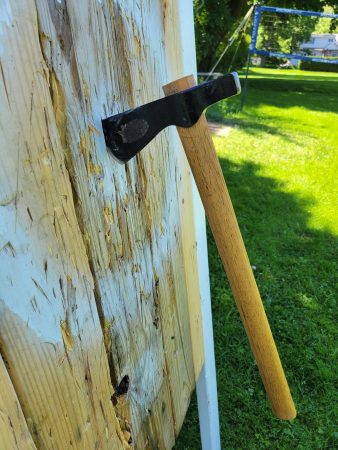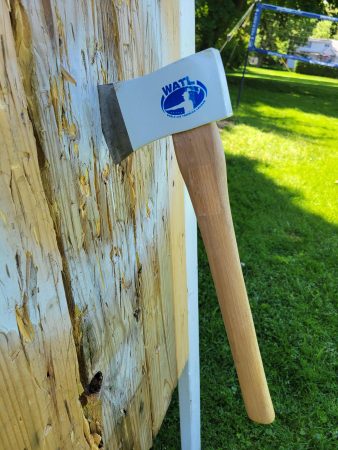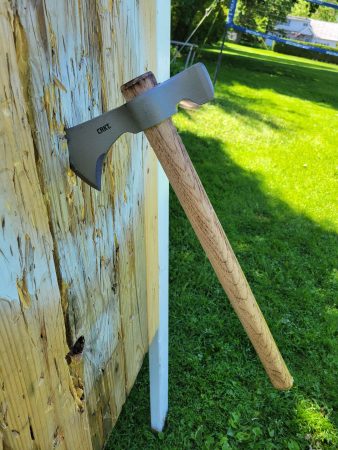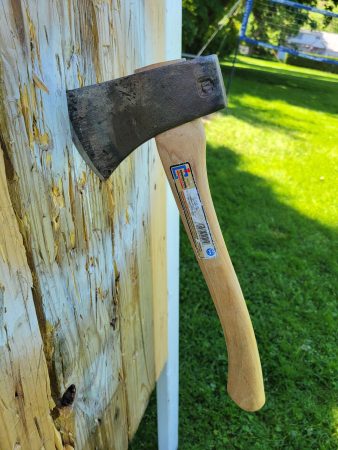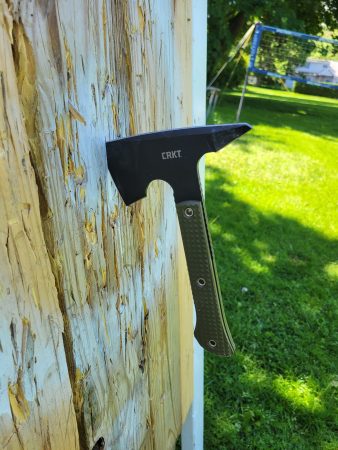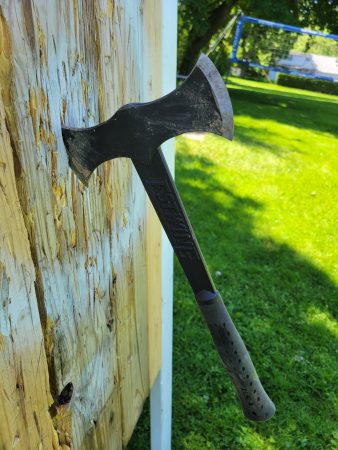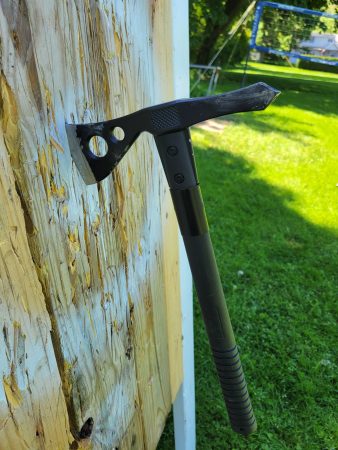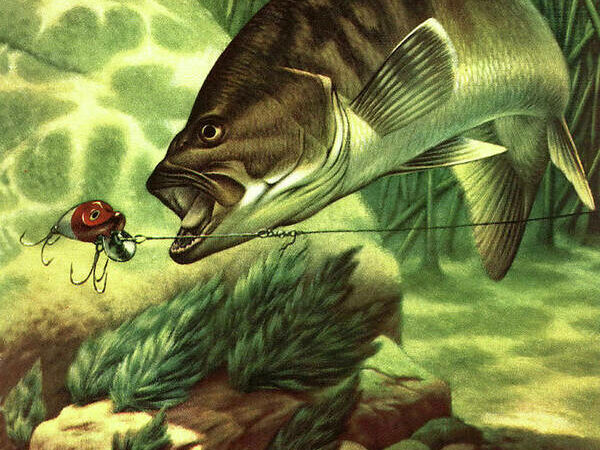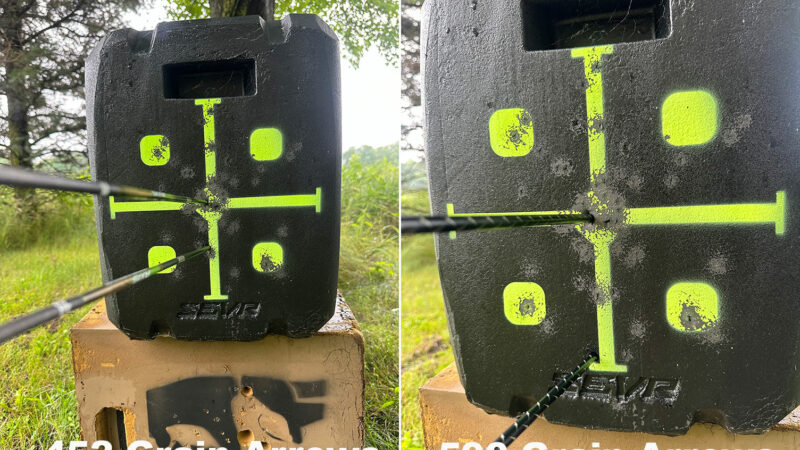The Best Throwing Axes of 2024, Tested and Reviewed
We may earn revenue from the products available on this page and participate in affiliate programs. Learn More ›
In recent years, axe throwing has exploded in popularity with axe throwing clubs, lounges, and leagues all over. There might be quantifiable reasons for this, but I think it’s due to the fact that throwing sharp objects is about as much fun as you can legally have.
I gathered a wide range of the best throwing axes and tomahawks and tested them to help you choose the tool that will fit your budget and style. So whether you’re looking for backyard fun or to dominate your local league, I’ve reviewed a throwing axe for you.
- Best Overall: WATL (World Axe Throwing League) Jack of Clubs
- Best Tomahawk: Cold Steel Trail Hawk
- Best Budget: WATL Competition Thrower
- Most Versatile Tomahawk: CRKT Woods Chogan
- Most Versatile Axe: Council Tool Flying Fox
- Best Spike Hawk: CRKT Jenny Wren Compact
- Estwing Black Eagle Double Bit Axe
- SOG Tactical Tomahawk
How I Tested the Best Throwing Axes
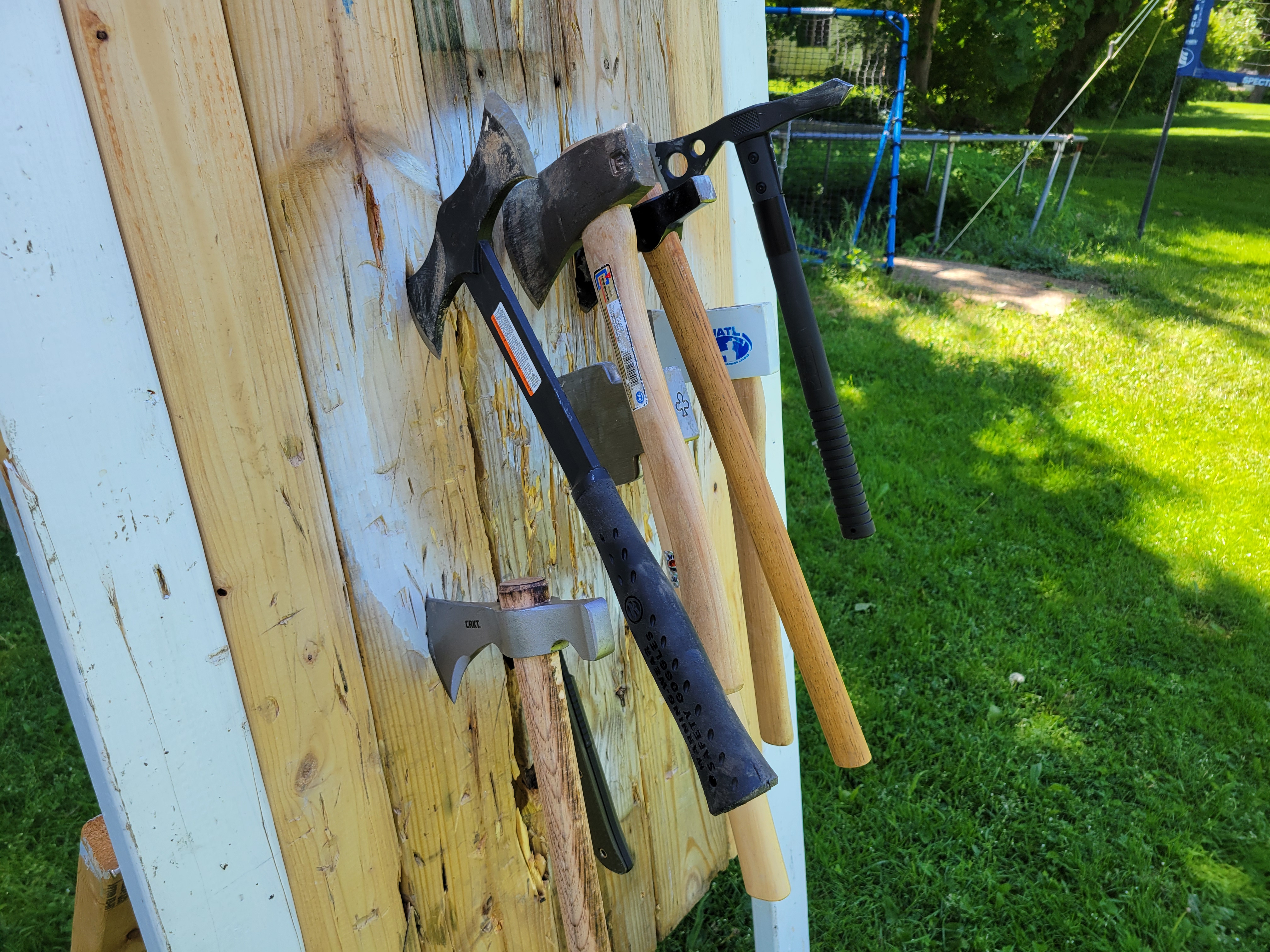
Photo by Drew Conover
The majority of the testing on these throwing axes and tomahawks was done during a range day with a bunch of friends. We set up rifle, pistol, skeet, and axe-throwing ranges. After our safety brief, everyone chose their sport and for over four hours, these axes and hawks did not get a break. The axe target always had a line of guys waiting to throw, and it was nothing but smiles. I asked everyone to give me their feedback on what worked best, and I also took some time to observe which tools everyone gravitated towards.
We had about 30 guys at the range day, and everyone took some time to try their hand at throwing, with a few guys that threw for the entire 4-plus-hour event. We kept things simple with a shorter distance (12 to 15 feet), which allowed for a single rotation before impact. This testing allowed me to see how the throwing axes held up to prolonged use and which consistently performed well for new and experienced throwers.
The Best Throwing Axes: Reviews and Recommendations
Best Overall: WATL (World Axe Throwing League) Jack of Clubs
Key Features
- Handle Length: 17-inches
- Handle Material: Straight-cut American hickory
- Head: Single bit, 1045 carbon steel
- Weight: 1.7-pound head, 2.25-pounds total
- Included padded nylon sheath
- Price: $118
Pros
- Thinnest blade profile, which made for the easiest sticks
- Meets all requirements for axe throwing competitions
- Excellent feel and balance while throwing
- Testers commented that the engravings look really cool
Cons
- More than double the cost of other axes tested
The WATL Jack of Clubs impressed everyone who threw it. That’s because it’s designed from the ground up as a throwing axe. It’s not an axe that will pull double duty as a hatchet or hammer; it’s a specialized tool made to stick into a target. The traditional wedge profile you’ll find on many of the best camping axes is great for chopping and splitting wood, but not ideal for sticking a throw. Instead of a wedge, the Jack of Clubs uses a thinned-out, convex-ground head to stick into the target with ease, even with a light throw.
I don’t want to say there were arguments over who got to throw this one, but it was the most requested and sought-after axe of the day. In the same way that a quality rifle or a quality instrument requires less effort to perform well, the Jack of Clubs gave beginners confidence and made it easier to get good results. It was the most forgiving axe to throw and made sticks even when the handle hit first on an under rotation or there was some over rotation. If I was looking to get a purpose-built throwing axe, the WATL Jack of Clubs would be my choice.
Best Tomahawk: Cold Steel Trail Hawk
Key Features
- Handle Length: 22-inches
- Handle Material: Tapered-cut American hickory
- Head: Single bit with hammer poll, 1055 carbon steel
- Weight: 1.5 pounds total
- Sheath not included, but available separately
- Price: $45
Pros
- Thin blade profile made for easy sticks
- Light
- Great feel and balance while throwing
- Hammer poll for extra functionality beyond throwing
Cons
- Handle can come loose after a bad throw (all authentic tomahawks can suffer from this)
- Not certified for competitions
The Cold Steel Trail Hawk has been in my collection for several years, and has been a great tool while camping. The hammer poll takes care of stakes and pegs, and the blade takes care of lighter chopping and brush clearing. When I get some downtime, it’s a blast to throw.
This was the favorite tomahawk among the testers and the one that everyone got the best results with. The Trail Hawk has a nice, thin edge profile that makes it great for throwing but it does hinder chopping a bit if you want a multi-use tool.
Like all tomahawks the head can loosen with use. So I reshaped the flare on the handle for a tighter fit, which helped a lot to keep the handle from popping loose if someone hit handle-first on a throw.
Best Budget: WATL Competition Thrower
Key Features
- Handle Length: 16 inches
- Handle Material: Straight-cut American hickory
- Head: Single bit, 1045 painted carbon steel
- Weight: 1.65-pound head, 2.35 pounds total
- Included padded nylon sheath
- Price: $50
Pros
- Thin blade profile makes for easy sticks
- Meets all requirements for competitions
- Strong enough to withstand lots of bad throws and mistakes
- Thick paint on head is very durable
Cons
- Handle is too thin at the bottom for throwers with large hands
- Rounded handle made indexing less precise
At first glance, the World Axe Throwing League Competition Thrower looks pretty much like a run-of-the-mill hatchet. It has a classic hatchet head shape, and the 16-inch handle makes it look normal, but a closer look reveals some design elements that set it apart. Most importantly, the blade has been thinned out, and the cheek blended back to make for much easier sticks over a regular hatchet.
Secondly, the handle has been cut straight with no swell or curve at the bottom. This helps the Competition Thrower leave your hand smoothly with no potential for hang ups. This hatchet was very popular among the testers and all agreed it was easy to throw and get consistent sticks in the target. If you’re looking to get into competition throwing and don’t want to break the bank, you can’t go wrong with the WATL Competition Thrower.
Most Versatile Tomahawk: CRKT Woods Chogan
Key Features
- Handle Length: 19 inches
- Handle Material: Straight-cut, Tennessee hickory with “burnt” finish
- Head: Single bit with hammer poll, 1055 carbon steel
- Total Weight: 1.99 pounds
- Optional leather sheath with belt loop
- Price: $55 without sheath, $65 with sheath
Pros
- Thin profile helps the blade stick
- Hammer poll adds utility
- Feels more like an axe than a tomahawk when throwing
Cons
- Not very sharp out of the box
- Took some work to get the head seated properly and it was very prone to slipping off on bad throws
The CRKT Woods Chogan was not designed to be a throwing hawk out of the gate, but it certainly gets the job done if you want to throw it. Its extra weight makes it a better chopping tool than most tomahawks and more like a throwing axe in hand. The hammer poll allows you to use the Woods Chogan for driving tent stakes, cracking nuts or whatever else you can use a hammer for in the woods.
The only problem I had with the Woods Chogan was the head fitment. Early on, it was very prone to slip off if the handle struck the target first. I had to whittle it just a bit to get a tighter, more secure fit. After that, it performed much better. While it may not be the easiest to throw for beginners, the Woods Chogan is very useful around camp, and it will still be a ton of fun to throw when you want to unwind.
Most Versatile Axe: Council Tool Flying Fox
Key Features
- Handle Length: 16 inches
- Handle Material: Curved and swelled American hickory
- Head: Single bit, 1060 carbon steel
- Weight: 1.75-pound head, 2.25 pounds total
- Optional leather sheath available
- Price: $56 or $75 with sheath
Pros
- Thin blade profile made for consistent sticks
- Meets all requirements for competitions
- Good feel for both throwing and chopping
- Poll is hardened for driving nails
Cons
- The optional leather mask is nice, but its an expensive add-on
- Handle should be treated with boiled linseed oil or similar before use
- Handle takes on dirt easily in factory trim
The Council Tool Flying Fox did very well when throwing and was comparable to the WATL Competition Thrower. However, the Flying Fox has some features that make it great for throwing and great around camp. The Council Tool is the only axe or tomahawk with a hardened hammer poll. This means that it can pound in nails without deforming. The other hammer polls are only suitable for pounding plastic or wood stakes.
The process of hardening the edge and the poll takes extra work, but it makes the Flying Fox stand out in this group. It really can do it all around the homestead and then be taken straight to an official competition. The palm swell and curve is present on the handle for better grip when chopping, but it’s not so exaggerated that it hooks your hand when throwing. A straight handle is best for throwing, but the Flying Fox still comes out of the hand smoothly even with the curves. If you need a tool that can get hard work done and still qualify for competition, the Flying Fox is the one for you.
Best Spike Hawk: CRKT Jenny Wren Compact
Key Features
- Handle Length: 10 inches
- Handle Material: Glass-reinforced, nylon scales over a one-piece axe design
- Head: Single bit with spike, SK-5 carbon steel
- Total Weight: 1.12 pounds
- Included molded thermoplastic sheath with multiple carry options
- Price: $119
Pros
- Thin blade profile and spike made for easy sticks front or back
- Head is sharpened in the front, top, and back which means it almost always sticks
- Best sheath in the test
- Lots of grip and easy to index
Cons
- Most expensive axe tested
- Short length requires an adjustment in throwing technique
A few testers had throwing experience, and I saw them throw underhand and no-spin techniques with the CRKT Jenny Wren. The Spike in the rear made lots of sticks when the axe over-rotated, which happened often due to the short handle. But, a stick is a stick.
While the top of the blade is sharpened and has the potential to stick, the bevel is a bit steep, and the Jenny Wren only stuck about half the time when that portion of the blade struck the target. The Jenny Wren was the easiest to experiment with different throwing styles, which made it a lot of fun to throw. I can’t say it was the best, but I was surprised with how well it did, and how much fun I had with it. The one-piece construction means this thing is basically indestructible, so new throwers don’t have to worry about breaking a handle or having it come loose. The CRKT Jenny Wren was a dark horse coming into this, but I was pleasantly surprised by how well it did.
Estwing Black Eagle Double Bit Axe
Key Features
- Handle Length: 17.9-inches
- Handle Material: Forged steel with rubber, over-molded grip
- Head: Double bit, forged steel
- Total Weight: 2 pounds
- Included plastic-reinforced nylon sheath
- Price: $53
Pros
- Nearly indestructible construction
- Comfortable grip
- Good feel and balance
Cons
- Thick edge geometry made this axe hard to stick, even after the target was worn in
The Estwing Black Eagle is basically bomb proof, and much of that comes from how the edge and cheek are ground thick. Most axes have a similar geometry to the Estwing, and that makes them better at splitting and pushing out chunks and chips while chopping. When it comes to throwing and sticking in the wood, a thinner grind behind the bevel and low angles are much better.
The Estwing is an incredibly robust hatchet that out splits most of the other throwing axes and hawks tested. But if you’re looking for an axe to throw, there are better options. Everyone had a hard time getting this to stick in the target, even with a good throw and perfect rotation. Towards the end of the day, as the target got increasingly beat up, it got a little easier to stick, but still not like any of the others. Again, if throwing is the goal, I would pass on the Estwing.
SOG Tactical Tomahawk
Key Features
- Handle: 15.75 inches
- Glass-reinforced nylon
- Head: Single bit with rear spike, 420 stainless steel
- Total Weight: 1.5 pounds
- Included, plastic-reinforced, ballistic-nylon sheath
- Price: $48
Pros
- Lightweight design takes less strength to throw
- Tough handle material
- Simple and useful sheath is included
Cons
- Thicker profile behind the edge didn’t stick too well until the target got “worn in”
- Spike is too thick and blunt to stick if you want to reverse throw
The SOG Tactical Tomahawk is not a traditional tomahawk, but it retains a similar feel and throws like one. The light handle lets this hawk rotate faster than others, so throwing is just a bit different. The bevel is a little steep for throwing, and this meant that it didn’t stick as well as other options when the target was fresh without a bunch of splits from other sticks. Once the target wore in, the Tactical Tomahawk performed much better. The SOG is built tough and should hold up well with newer throwers and the mistakes everyone inevitably makes when they are learning. While its not the easiest to stick, it is a lightweight option for younger throwers who may have a hard time with a heavier axe or hawk. Or if you want a hawk that can be thrown and then used to dig a hole or used as a breaching tool, the SOG Tactical Hawk might be right for you.
How to Choose the Best Throwing Axe
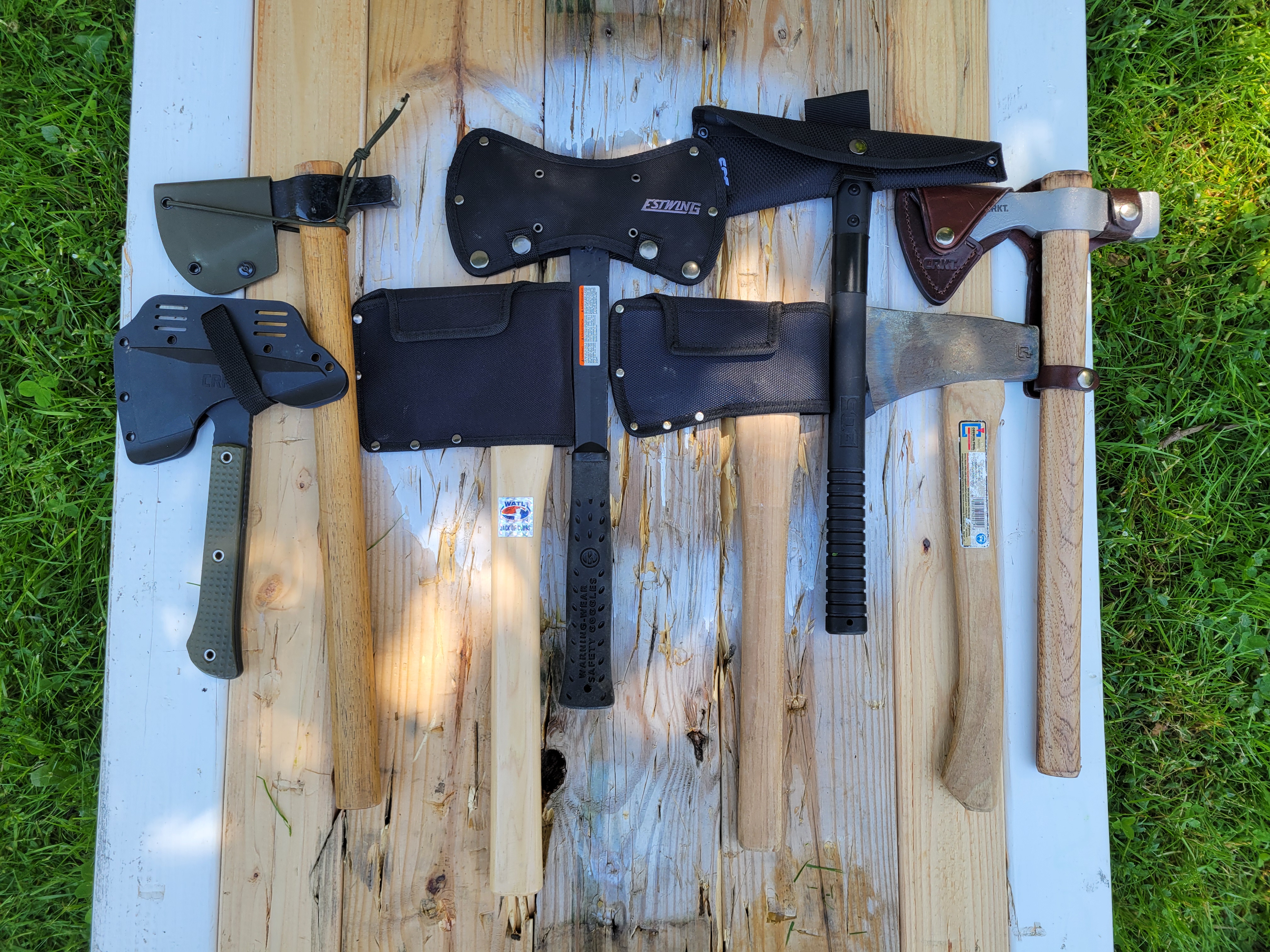
Photo by Drew Conover
Budget
When you’re looking to buy a throwing axe or hawk, figure out how much you want to spend. In general, if you can set aside $40 to $50, you can grab a quality axe or hawk. However, if you have a little extra to spend, the Jack of Clubs ($120) is head and shoulders above the rest in my opinion.
Experience
While the high-end throwers are excellent, they may not be the best axe to start with. Some of the testers were new throwers and they were trying to get the axes and hawks through the target instead of to the target. You would think they were trying out for the fastball competition. The Jack of Clubs is ground thinner than the rest, and that helps it stick well, but also makes it more susceptible to bending than the others.
If you or someone who will be throwing with you tends to be hard on equipment, it might be better to start with something a little more robust like the WATL Competition Thrower, the Flying Fox, or the Woods Chogan, all of have a thicker blade stock that will hold up to a sideways hit. Many throwing businesses use the Competition Thrower and Flying Fox axes for their rental axes because they throw well, and can take a real beating.
Weight
For younger throwers, some of the competition weight axes can be a little much to start with. A lightweight tomahawk like the SOG or Cold Steel will be much easier for them to get downrange, and probably safer as well. If they can’t hold the axe straight on the back swing, bad things can happen in a hurry as it comes forward.
FAQ
A: World Axe Throwing League has two official distances of 12 and 15 feet. Everyone throws from 12 feet, and advanced throwers complete the second half of the match from 15 feet. If you want to practice for competition, 12 feet would be the best place to start. However, if you’re just throwing for fun, experiment and try different ranges.
A: There are plenty of online tutorials from pros and advanced throwers, but I’ll share some tips. I try to keep my shoulder, elbow, and hand all on the same plane from wind up to release. On the wind up, I have my elbow bent about 90 degrees, and bring it about in line with my face. As you swing forward towards the target, I’m releasing with my hand about head level. Also, make sure the bit (blade) is pointing straight at the target, and that it’s not off to one side of the other. The reality is, you’re going to have to get out there and try it to see what works best for you. Just be careful and take your time.
A: There are targets for sale that are regulation size and well made. But, I made a target out of scrap 2x4s and 2x6s. I laid them all flat next to each other and laid boards at the top and bottom, and screwed them on from the back. Then I put some legs on the back with old door hinges so I could fold it up and put it away when not in use. Outside of that, dead trees, old stumps, and rounds cut out of logs will all work for targets as well. Just make sure you have a backstop or lots of room behind your target because you will miss in the beginning.
Final Thoughts on the Best Throwing Axes
Throwing axes and tomahawks is a ton of fun, but choosing the right ones can make a big difference in your success and level of fun. The good news is that there is a solid throwing axe or hawk for just about every budget and skill level. If you have access to a throwing venue, see what they are using and perhaps try some out before you commit to buying one. While throwing sharp objects is a lot of fun, it can also become dangerous in a hurry. Stay safe when throwing. Keep track of kids and pets and stay focused during and after the throw — these things can and will bounce back at times. Get out there, throw some sharp things, and have a blast.
- Best Overall: WATL (World Axe Throwing League) Jack of Clubs
- Best Tomahawk: Cold Steel Trail Hawk
- Best Budget: WATL Competition Thrower
- Most Versatile Tomahawk: CRKT Woods Chogan
- Most Versatile Axe: Council Tool Flying Fox
- Best Spike Hawk: CRKT Jenny Wren Compact
- Estwing Black Eagle Double Bit Axe
- SOG Tactical Tomahawk
The post The Best Throwing Axes of 2024, Tested and Reviewed appeared first on Outdoor Life.
Source: https://www.outdoorlife.com/gear/best-throwing-axes/
